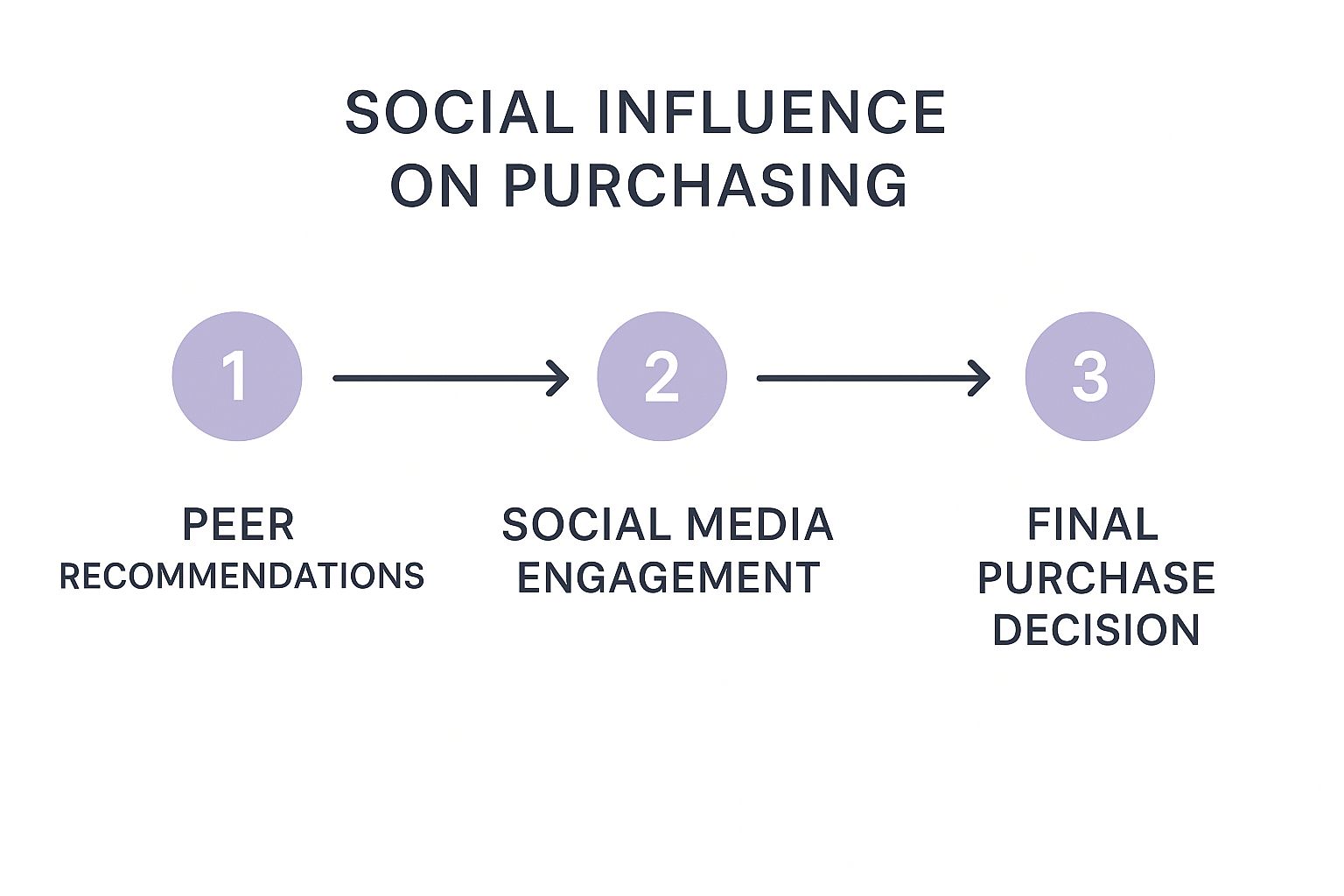The Real Power Behind Consumer Behavior in Marketing
Consumer behavior in marketing is much more than simply tracking purchases. It’s about understanding the motivations behind those purchases. This deeper understanding forms the basis of truly effective marketing strategies that connect with target audiences and drive sales. It requires moving beyond surface-level demographics and exploring the psychological, social, and economic factors that shape buying decisions.
Why Understanding “Why” Matters
Imagine two customers buying the same brand of coffee. One buys it out of habit, the other specifically chooses it for its ethical sourcing. Understanding these distinct motivations allows marketers to tailor their messaging and cultivate stronger relationships with each customer. For the habitual buyer, ensuring consistent product availability and competitive pricing might be key. For the ethically conscious buyer, highlighting the brand’s commitment to fair trade practices would be far more effective.
The Evolution of Consumer Behavior Analysis
Consumer behavior analysis has evolved significantly. Early on, marketers relied on broad demographic categories like age and income. However, this approach often overlooked the nuances of individual motivations. Now, behavioral modeling and data analysis techniques allow marketers to understand consumer needs at a much deeper level. This includes analyzing online behavior, social media interactions, and even physiological responses to marketing stimuli.
Key Factors Influencing Buying Decisions
Several factors contribute to the complex decision-making process of consumers. These can be broadly categorized as:
Psychological: These are internal factors like motivations, perceptions, and attitudes. For example, someone might purchase a luxury car not just for transportation, but for the status associated with it.
Social: Social influences, including family, friends, and cultural norms, have a substantial impact. The rise of social media has amplified this effect, with peer recommendations and influencer marketing playing a significant role in buying decisions.
Economic: A consumer’s disposable income, perceived value, and price sensitivity also heavily influence their behavior. A consumer might opt for a less expensive option even if they prefer a premium brand simply due to budget constraints. Understanding the perceived value of your product or service is crucial for effective pricing.
By understanding how these factors interact, marketers can anticipate consumer reactions to market changes, identify emerging trends, and develop strategies that resonate with their target audience. This empowers brands to move from reacting to market trends to actively shaping them. For instance, recognizing the growing importance of sustainability has led many brands to develop eco-friendly products and emphasize their commitment to environmental responsibility in their marketing campaigns. This is more than just following a trend – it’s about aligning with evolving consumer values to build lasting brand loyalty.
The Psychology That Drives Buying Decisions

Effective marketing campaigns understand what makes consumers tick. This means understanding the cognitive biases and mental shortcuts that influence buying decisions. These subconscious processes significantly impact how consumers view products, brands, and marketing messages.
The Power of Cognitive Biases
One key bias is confirmation bias. This is the tendency to favor information that supports existing beliefs and dismiss anything that challenges them. For marketers, confirmation bias can strengthen brand loyalty. Customers who are already fans of a brand are more likely to accept its messaging and less inclined to consider competitors.
Another important bias is loss aversion. This principle suggests that the pain of losing something outweighs the pleasure of gaining something of equal value. This explains the effectiveness of limited-time offers and scarcity tactics. The fear of missing out (FOMO) is a powerful motivator.
Leveraging Social Proof and Authority
Successful brands utilize social proof to sway consumer behavior. Social proof is the idea that people are more likely to do something if they see others doing it. Testimonials, reviews, and influencer endorsements all capitalize on this principle. They demonstrate that others value the product or service, increasing its appeal to potential customers.
Similarly, the principle of authority can strongly influence buying decisions. Consumers tend to trust figures seen as experts or authority figures. This is why brands partner with doctors, scientists, or other credible individuals to endorse their products.
The Importance of Emotional Connections
Rational arguments are important, but emotional connections often carry more weight in consumer decision-making. Consumers aren’t always logical. They are driven by emotions, desires, and aspirations. Good marketing acknowledges this and crafts messages that resonate emotionally.
A key trend in current consumer behavior is a growing focus on self-sufficiency. A recent study revealed that 68% of global consumers now prioritize managing their health, finances, and lifestyle independently, a notable increase from 52% in previous years. Factors like rising food costs and market volatility contribute to this shift. Find more detailed statistics here This insight allows marketers to create campaigns that align with these evolving priorities, emphasizing self-reliance and control.
Ethical Considerations in Applying Psychology
It’s essential to use these psychological principles ethically. Manipulative tactics can damage a brand’s reputation and erode consumer trust. Transparency, honesty, and genuine value creation should guide marketing strategies. By understanding the psychology of buying decisions, marketers can build campaigns that are both effective and ethical, connect with consumers on a deeper level, build lasting relationships, and drive business success.
Mastering the Consumer Decision Journey
Forget outdated marketing funnels. Today’s consumer decision journey is dynamic and far from linear. Think of it less like a straight line and more like a winding road with many on and off-ramps. Understanding this journey is crucial for effective marketing.
Stages of the Consumer Decision Journey
While individual paths may differ, the consumer decision journey generally includes these key stages:
Problem Recognition: The journey starts when a consumer realizes they have a need or a problem. This could range from needing new running shoes to desiring a career change. Marketing at this stage often focuses on highlighting the pain point and presenting the product or service as the solution.
Information Search: After recognizing a problem, the consumer starts looking for information. This could involve researching online, checking product reviews, discussing options with friends and family, or visiting retail locations. Making valuable information easily accessible is vital for marketers during this stage.
Evaluation of Alternatives: With information gathered, consumers start assessing their options. They compare features, prices, and benefits of different products or services. Marketers can influence this by showcasing the unique advantages of their offerings and addressing any potential concerns.
Purchase Decision: This is where the consumer commits to a purchase. However, even here, factors like unexpected shipping costs or negative reviews can halt the sale. Simplifying the purchase process and providing excellent customer service is essential for boosting conversion rates.
Post-Purchase Behavior: The journey extends beyond the initial purchase. The consumer’s post-purchase experience, such as customer service and product satisfaction, has a significant impact on their future purchasing decisions and brand loyalty. Encouraging reviews, offering continued support, and nurturing a community can encourage positive post-purchase behavior.
To understand these stages better, let’s examine the following table:
The 5 Stages of Consumer Decision-Making
This table breaks down each stage of the consumer decision-making process, highlighting key consumer activities and effective marketing strategies for each phase.
| Decision Stage | Consumer Activity | Effective Marketing Strategies | Common Pitfalls |
|---|---|---|---|
| Problem Recognition | Identifying a need or want | Content marketing highlighting pain points; targeted advertising | Not clearly defining the problem or offering a relevant solution |
| Information Search | Researching online, reading reviews, comparing products | SEO optimization, informative content, readily available product information | Difficult-to-find information, poor website navigation |
| Evaluation of Alternatives | Comparing features, prices, and benefits | Competitive analysis, highlighting unique selling propositions, addressing concerns | Overwhelming consumers with too much information, not clearly differentiating from competitors |
| Purchase Decision | Adding to cart, completing checkout | Streamlined checkout process, secure payment options, excellent customer service | Hidden costs, complex checkout process, poor customer service |
| Post-Purchase Behavior | Using the product, leaving reviews, contacting customer service | Follow-up emails, loyalty programs, community building | Lack of customer support, ignoring negative feedback |
As the table illustrates, understanding each stage of the consumer decision-making process allows marketers to tailor their strategies for maximum impact.
The Influence of Social Interactions
Social interactions significantly influence consumer behavior. From word-of-mouth recommendations to engaging on social media platforms like Facebook, these interactions can significantly sway purchase decisions. The following infographic illustrates the flow of social influence:

The process often begins with a recommendation from a friend or family member. This leads to social media engagement where consumers look for additional information and validation. Finally, it often ends with a purchase decision. This highlights the importance of having a robust social media presence and fostering positive word-of-mouth for any brand.
Touchpoints and Messaging
Different touchpoints prove effective at various stages of the journey. For example, during the information search, consumers might rely on search engines like Google and online review platforms. When evaluating alternatives, comparison websites and expert opinions become more influential. Adapting your messaging to each stage and touchpoint is essential for maximizing impact.
Creating Consistent and Personalized Experiences
Consumers today expect consistent experiences across all touchpoints, from a company website to its social media presence and customer service interactions. At the same time, they value personalization. Striking a balance between these two is crucial for any brand. By using data and technology, companies can create targeted campaigns that resonate with individual consumers while still maintaining a consistent brand identity. This involves understanding not only what consumers purchase, but also why they make those purchases, and tailoring your communication accordingly. This targeted approach enables stronger customer relationships, greater brand loyalty, and increased sales.
Environmental Forces Reshaping Buyer Behavior

Consumer behavior in marketing is always changing. It’s influenced by powerful environmental forces, from cultural shifts and economic pressures to ongoing social movements. These external factors significantly impact purchasing motivations. For marketers, understanding these dynamics is key to staying relevant and connecting with their target audience.
Cultural Shifts and Shared Experiences
Cultural shifts are major drivers in reshaping how consumers behave. These shifts are often rooted in shared experiences, like global events or technological advancements. These experiences can lead to lasting changes in attitudes and values.
For example, the growing awareness of sustainability has increased demand for eco-friendly products and ethical business practices. Brands must adapt their strategies to reflect these values to connect with today’s consumers. Shared experiences can also create a sense of community, influencing purchasing decisions based on collective values.
Economic Pressures and Consumer Priorities
Economic fluctuations have a big impact on consumer behavior. During times of economic uncertainty, consumers become more price-sensitive. They prioritize essential purchases, often leading to decreased spending on non-essential items. This shift results in more value-seeking behavior.
Interestingly, even during economic downturns, some product categories might thrive. These can include products related to home improvement or entertainment. Understanding these shifts in priorities is crucial for marketers to adjust their messaging and product offerings effectively. Brands must consider how their products and services meet the specific needs of consumers in different economic climates.
Social Movements and Brand Values
Social movements significantly impact consumer behavior. Consumers increasingly support brands that align with their values, especially regarding social responsibility and ethical practices. This trend has led to increased demand for transparency and accountability from businesses.
Consumers are more likely to support companies that actively demonstrate their commitment to these values. This highlights the importance of brand authenticity. Companies need to truly embody the principles they promote. Misalignment with consumer values can result in boycotts and damage a brand’s reputation. Conversely, supporting social causes can build brand loyalty and attract new customers. The home environment, for example, has become central to new consumer behaviors as individuals seek authenticity and comfort amid global instability. Explore this topic further.
Anticipating and Capitalizing on Market Changes
Marketers who closely monitor cultural shifts, economic trends, and social movements can better anticipate consumer reactions to market changes. Identifying emerging trends before competitors offers a significant advantage. It allows brands to position themselves strategically and capitalize on evolving consumer priorities. This proactive approach empowers companies to shape market forces, resulting in greater brand relevance and long-term success.
Tech Disruptions Transforming Consumer Expectations
Technology is fundamentally reshaping consumer behavior in marketing. It’s changing how people research products, make purchases, and interact with brands. This shift demands that businesses adapt and embrace these changes to successfully meet evolving customer expectations.
The Rise of the Omnichannel Experience
The sheer number of devices and platforms available today means consumers interact with brands across multiple touchpoints. This makes a consistent omnichannel customer journey crucial. Consumers expect a seamless experience, regardless of whether they’re browsing a website on their laptop, using a mobile app, or visiting a brick-and-mortar store.
For example, imagine a customer adding an item to their online shopping cart, then visiting a physical store to try it on before finally completing the purchase. This fluid movement between online and offline channels is the new normal.
Personalization: The Double-Edged Sword
Data-driven personalization is another significant disruption. Artificial Intelligence (AI) is increasingly used to tailor product recommendations, personalize advertising, and craft customized shopping experiences. While this can significantly boost customer satisfaction, it also raises valid privacy concerns.
This creates a delicate balance, what some call the “personalization paradox.” Consumers desire personalized experiences but are simultaneously cautious about how companies collect and utilize their data. Marketers must address this challenge head-on.
Transparency and giving consumers control over their data are essential for building and maintaining trust. Allowing users to opt-out of personalized advertising, for instance, can address privacy anxieties while still allowing businesses to leverage data for valuable insights.
Beyond the Hype: Technologies Influencing Purchase Decisions
Not every new technology significantly impacts purchasing behavior. Some generate considerable buzz, yet their actual influence on consumers remains minimal. Marketers must discern between hype and genuine impact.
A more effective strategy involves focusing on technologies that genuinely enhance the customer experience, rather than simply chasing the latest trends. While virtual reality (VR) and augmented reality (AR) present exciting possibilities, their current adoption rates and influence on sales are still relatively low. This is especially true when compared to technologies like mobile commerce and AI-driven personalization.
Technology, particularly AI, is central to shaping current consumer shopping habits. According to Statista, over 60% of consumers now expect tailored recommendations based on their purchase history. Additionally, more than 40% of online shoppers use AI-powered chatbots for customer support. You can explore more detailed statistics here: Consumer Trends 2025
To illustrate how technology is influencing consumer behavior, let’s take a look at the following table:
Technology’s Influence on Consumer Behavior
This table presents statistics on how different technologies are influencing consumer behavior across demographics and regions.
| Technology | Adoption Rate | Primary Consumer Impact | Regional Variations |
|---|---|---|---|
| Mobile Commerce | High (Over 60% of online transactions) | Increased convenience and accessibility to shopping | Higher adoption in Asia-Pacific than North America |
| AI-Driven Personalization | Growing (Over 60% expect tailored recommendations) | Enhanced customer experience and product discovery | Adoption varies based on data privacy regulations in different regions |
| Chatbots | Moderate (Over 40% use for support) | Improved customer service and quicker response times | Higher adoption in regions with strong customer service expectations |
| VR/AR | Low (Less than 10% regular usage for shopping) | Immersive product experiences but limited practical application | Adoption concentrated in tech-savvy urban areas |
This table highlights the varying adoption rates and consumer impact of different technologies. While mobile commerce and AI personalization are seeing widespread adoption, VR/AR are still in their early stages. Regional differences also play a role, influenced by factors like data privacy regulations and cultural preferences.
Tech-Enabled Experiences That Drive Results
Forward-thinking brands are developing tech-enabled experiences that truly resonate with consumers. This goes beyond simple automation; it involves leveraging technology to forge stronger customer relationships, offer personalized service, and create memorable interactions.
A key component of this approach involves using technology to gather and analyze customer feedback. Understanding the evolving needs of your target audience allows businesses to adapt strategies accordingly. This proactive approach enables companies to anticipate and meet changing expectations shaped by technological advancements. For example, incorporating customer feedback directly into product development and service offerings ensures that tech advancements actually align with consumer preferences, ultimately driving measurable results.
Actionable Strategies That Actually Influence Behavior

Understanding consumer behavior is vital for marketing success. But knowing how consumers think is only half the battle. The real challenge lies in turning that knowledge into effective strategies that drive action. This section explores practical, results-oriented techniques to influence consumer choices.
Crafting Compelling Value Propositions
A strong value proposition is essential. It explains the unique benefits of your product or service, highlighting why a customer should choose you over competitors. However, simply listing features isn’t enough. The key is to connect those features to the customer’s needs and motivations.
For example, instead of saying your software “has advanced reporting features,” focus on the outcome. Explain how these features “empower data-driven decisions that boost profitability.” This directly addresses the desire for business growth, making the value clear and compelling.
Pricing Psychology: Perceived Value vs. Actual Cost
Price has a significant impact on consumer behavior. But the connection between price and perceived value isn’t always straightforward. Pricing psychology plays a crucial role. Techniques like charm pricing (using .99 endings) and prestige pricing (setting higher prices to signal exclusivity) can sway buying decisions.
Framing the price in relation to its benefits also influences perceived value. If a product is more expensive but also more durable, highlighting long-term cost savings can justify the higher upfront investment.
Distribution Strategies for Competitive Advantage
Effective distribution strategies are crucial for reaching your target audience. This involves carefully choosing where and how customers can buy your product. The growth of e-commerce necessitates a robust online presence, while some products might benefit from exclusive retail partnerships or direct-to-consumer approaches.
Partnering with a major online retailer can broaden your reach. Alternatively, creating a unique in-store experience can distinguish your brand and cultivate stronger customer relationships. This involves carefully considering the entire customer journey, ensuring seamless purchase options at every touchpoint.
Leveraging Social Influence Beyond Testimonials
Social influence has a profound impact on consumer decisions. While testimonials are helpful, other techniques can amplify their effect. Building online communities, encouraging user-generated content, and collaborating with influencers are all proven strategies.
Creating a Facebook group where customers share their product experiences builds a sense of community and trust. This organic interaction can be far more persuasive than traditional advertising.
Sensory Marketing and Brand Association
Sensory marketing uses the power of the senses to build positive brand connections. Using elements like scent, sound, and visuals can evoke emotions and create a memorable experience.
Consider the distinct smell of a coffee shop or the energetic music playing in a retail store. These sensory cues significantly contribute to the overall brand experience and can influence purchase decisions.
Neuroscience and Effective Messaging
Neuromarketing is an emerging field. It explores the neuroscience behind messaging. By understanding how the brain processes information and reacts to different stimuli, marketers can create more persuasive campaigns.
Research shows that visuals with contrasting colors and dynamic movement capture attention more effectively. Applying these insights can boost the impact of your marketing materials.
Ethical Considerations and Transparency
Implementing these strategies requires careful attention to ethical considerations. Transparency and honesty are vital. Avoid manipulative tactics or misleading claims. Building trust is fundamental for long-term success. An ethical approach protects consumers and strengthens your brand’s reputation, fostering lasting customer loyalty. To improve customer loyalty, review successful customer retention strategies. By prioritizing ethical marketing practices, you build a brand that consumers trust and choose to support.
Future-Proofing Your Strategy: Consumer Behavior Trends
The brands that will dominate tomorrow are focusing on emerging consumer behavior shifts today. To truly future-proof your marketing strategy, you need to anticipate and adapt to these evolving trends.
The Sustainability Imperative
Consumer demand for sustainable products is no longer a niche trend; it’s a core expectation. This goes beyond simply offering recycled packaging. It includes transparency about sourcing, manufacturing processes, and the entire product lifecycle.
Consumers are holding brands accountable for their environmental impact, rewarding those that prioritize sustainability and penalizing those that don’t. This means brands need to integrate sustainability into every aspect of their operations, from product development to marketing messages.
The Privacy Paradox: Balancing Personalization and Data Protection
Consumers appreciate personalized experiences. However, they’re increasingly wary of how companies collect and use their data. This creates the privacy paradox.
Brands need to be transparent about data collection practices and give consumers control over their information. Offering clear opt-out options and explaining how data is used to enhance their experience, not exploit it, builds trust and encourages engagement. To improve customer loyalty, review successful customer retention strategies.
The Rise of New Consumer Segments
Demographic shifts are creating new consumer segments with distinct values and preferences. For example, Gen Z consumers prioritize authenticity and social impact.
They’re more likely to support brands that align with their values and actively engage in social causes. This requires a deeper understanding of each segment’s motivations and tailoring your messaging accordingly.
Convenience Is King: Meeting Evolving Expectations
In today’s fast-paced world, convenience is paramount. Consumers expect seamless experiences across all touchpoints, from online shopping to in-store interactions.
This means optimizing websites for mobile, offering multiple delivery options, and providing exceptional customer service. These convenience benchmarks are no longer optional; they’re essential for staying competitive.
Blurring the Lines: The Digital/Physical Experience Blend
The lines between digital and physical experiences are blurring. Consumers might research products online, try them on in a store, and then complete the purchase through a mobile app.
This blended experience requires brands to create a consistent and integrated journey across all channels. This omnichannel approach ensures a seamless and satisfying customer experience, regardless of how they choose to interact with your brand.
Practical Frameworks for Trend Monitoring
Staying ahead of the curve requires proactive monitoring of consumer behavior changes. Here are some key steps:
Market Research: Conduct regular market research, including surveys, focus groups, and social listening, to understand evolving consumer needs.
Trend Analysis: Analyze industry publications, social media trends, and competitor activities to identify emerging patterns.
Data Analytics: Leverage website analytics, customer relationship management (CRM) data, and other sources to track consumer behavior and identify key trends.
By adopting these frameworks, brands can gain valuable insights into consumer shifts, anticipate market changes, and position themselves for long-term success. This proactive approach allows you to capitalize on emerging opportunities and remain ahead of the competition.
Ready to take your marketing to the next level? Notifyio provides the insights and resources you need to understand and influence consumer behavior. Visit Notifyio today to explore our expert articles, case studies, and practical strategies for maximizing your marketing impact.




Leave a Reply